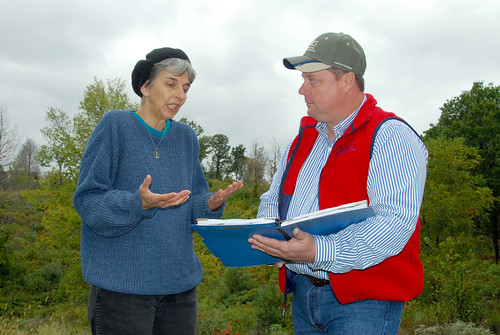
Theresa Lackey, of Ashland, Missouri, said she had a general idea about the improvements she wanted to make to the 32 acres of mostly overgrown woods around her home. But she credits a conservation plan that she developed with assistance from the USDA’s Natural Resources Conservation Service, (NRCS), for helping turn her goals into reality.
“What NRCS did was work with us to create a plan for our goals,” she said. “Developing the plan helped us clarify what our goals were, and it helped clarify a process to move in that direction.”
Tony Hoover, the NRCS district conservationist serving Boone County, Missouri, said conservation plans are voluntary and free. He said the plans are simply putting on paper what landowners wish to do with their land. They are designed to be flexible, and they often change depending on land and resource changes, and as new conservation programs are developed.
Lackey said the conservation planning process was easy and beneficial.
“The folks at NRCS walked around the farm with us and we just kind of brainstormed and talked about what we wanted. Then they helped guide us in the programs that they had that would match what we wanted to accomplish.”
Lackey said the technical assistance that NRCS and its conservation partners provide is invaluable.
“For us the biggest help was having resource people that would help us prepare the plan, interpret the plan, adjust the plan and guide us in our next steps,” she said.
She added that the financial assistance that is possible once a conservation plan is developed was also welcome. With an active conservation plan, landowners and USDA employees can more easily identify USDA financial assistance opportunities.
“It helped things happen faster in a more consolidated way than we could do by ourselves,” said Lackey.
She said financial assistance from NRCS allowed her to hire a crew to cut 10 acres of cedar trees and burn them. Before, she and her husband, David, would work a whole weekend and only be able to clear a small area.
Hoover said work already completed on Lackey’s land includes upland wildlife habitat management, restoration and management of rare and declining habitats, conservation cover, prescribed burning, and establishing pollinator habitat. NRCS provided about $15,000 to assist with the cost of those improvements. The work will ultimately lead to the land returning to its natural, pre-settlement condition. Instead of cedar trees, the area will feature open areas, wildflowers and other native plants, and wildlife naturally suited to those areas should return.
Lackey said she is pleased with the changes to her land, and she credits developing and following a conservation plan with helping make those changes happen.
“The conservation plan gives us an enthusiasm and motivation for continuing to move forward in creating a dream that we want here,” she said.
